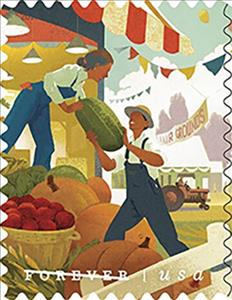Stamp: Farmers Unloading Produce (United States of America 2019)
Farmers Unloading Produce (United States of America 2019)
25 July (United States of America ) within release State & County Fairs goes into circulation Stamp Farmers Unloading Produce face value FOREVER No Face Value
| Stamp Farmers Unloading Produce in catalogues | |
|---|---|
| Michel: | Mi: US 5638 |
| Stamp Number: | Sn: US 5401 |
Stamp is vertical format.
stamp from se-tenant strip of four. Face value US$0.55 on day of issueAlso in the issue State & County Fairs:
- Stamp - Child with Rooster and Ferris Wheel face value FOREVER;
- Stamp - Families Touring The Fair face value FOREVER;
- Se-tenant - State and County Fairs face value 4*FOREVER;
- Stamp - Children Buying Sweets At Concession Stand face value FOREVER;
- Stamp - Farmers Unloading Produce face value FOREVER;
- Full Pane - State and County Fairs face value FOREVER;
Stamp Farmers Unloading Produce it reflects the thematic directions:
Agriculture is the cultivation and breeding of animals, plants and fungi for food, fiber, biofuel, medicinal plants and other products used to sustain and enhance human life.[1] Agriculture was the key development in the rise of sedentary human civilization, whereby farming of domesticated species created food surpluses that nurtured the development of civilization. The study of agriculture is known as agricultural science. The history of agriculture dates back thousands of years, and its development has been driven and defined by greatly different climates, cultures, and technologies. Industrial agriculture based on large-scale monoculture farming has become the dominant agricultural methodology.
A fair (archaic: faire or fayre) is a gathering of people for a variety of entertainment or commercial activities. Fairs are typically temporary with scheduled times lasting from an afternoon to several weeks. Fairs showcase a wide range of goods, products, and services, and often include competitions, exhibitions, and educational activities. Fairs can be thematic, focusing on specific industries or interests.
In botany, a fruit is the seed-bearing structure in flowering plants (also known as angiosperms) formed from the ovary after flowering. Fruits are the means by which angiosperms disseminate seeds. Edible fruits, in particular, have propagated with the movements of humans and animals in a symbiotic relationship as a means for seed dispersal and nutrition; in fact, humans and many animals have become dependent on fruits as a source of food. Accordingly, fruits account for a substantial fraction of the world's agricultural output, and some (such as the apple and the pomegranate) have acquired extensive cultural and symbolic meanings. In common language usage, "fruit" normally means the fleshy seed-associated structures of a plant that are sweet or sour, and edible in the raw state, such as apples, bananas, grapes, lemons, oranges, and strawberries. On the other hand, in botanical usage, "fruit" includes many structures that are not commonly called "fruits", such as bean pods, corn kernels, tomatoes, and wheat grains. The section of a fungus that produces spores is also called a fruiting body.



